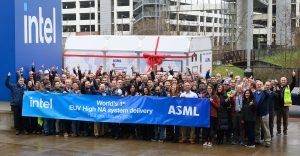By Dr. Larry Williams, Distinguished Engineer at ANSYS Inc.
Technological Innovations
There are a number of technological innovations that I predict will turn heads in 2024.
First, continued 3D-IC and heterogeneous integration. The slowing of Dennard Scaling and Moore’s Law can be mitigated in part by 3D-IC integration, but 3D-IC has several multiphysics challenges like thermal integrity, mechanical stress, and warpage. This is due to differential thermal expansion, electromagnetic modeling for signal integrity, and full-system power integrity. These trends drive the industry to add simulation of novel physical effects as part of integrated EDA workflows. Ansys RedHawk-SC Electrothermal offers a gold-standard technology platform to examine and simulate the multiphysics behavior of 2.5D and 3D-IC designs. Designers use it to model and analyze the full-system multiphysics of entire 3D-IC designs, including chip, interposer, package, and system boundary conditions. RedHawk-SC Electrothermal relies on core solver technology from trusted golden signoff tools including RedHawk-SC™, HFSS™, Icepak™, Ansys Mechanical™, and more, to provide a comprehensive workflow for the multiphysics challenges.
From these innovations, it’s clear that 3D-IC technology is driving an inflection point in semiconductor design, which has spurred Ansys and the entire EDA industry to retool with an expanded set of multiphysics capabilities that will still be undergoing rapid advances in 2024.
At the Consumer Electronics Show (CES) 2024, Siemens unveiled a series of innovations in artificial intelligence (AI) and immersive engineering, marking significant strides towards the realization of the industrial metaverse. The event saw Siemens collaborating with industry giants such as Sony, Amazon Web Services (AWS), Red Bull Racing, Unlimited Tomorrow, and Blendhub, highlighting the transformative impact of technology in various sectors.
By Jacek Hanke, CEO, Digital Core Design
Pioneering the Path Ahead: Digital Core Design’s CEO Forecasts Industry Trends for 2024

Jacek Hanke
As we stand on the brink of 2024, the landscape of our industry is on the verge of unprecedented transformation. This year holds special significance for Digital Core Design (DCD) as we celebrate our 25th anniversary – a quarter-century of actively shaping the IT market since our inception in 1999.
At the core of our industry lies the pulse of technological advancements, and 2024 promises a symphony of breakthroughs. A notable paradigm shift is imminent, poised to redefine connectivity on multiple levels. The evolution of RISC-V technology, in particular, is set to bring forth new and powerful solutions. DCD plans to capitalize on this by launching advanced 32-bit and 64-bit RISC-V CPUs with accompanying peripherals, empowering companies to construct more robust and innovative systems.
Safety and security, integral aspects of technological progress, will run parallel to our new product offerings. Noteworthy is our CAN XL IP Core, which, equipped with Functional Safety Functions, provides a comprehensive solution, especially in the automotive sector. As we focus on safety, the importance of security becomes apparent. From our perspective, deeply embedded hardware security, exemplified by DCD’s CryptOne cryptographic system, is becoming a necessity in new designs, given the increasing threats at the lowest integration level.
By Ken Butler, Business Development Senior Director, Advantest Cloud Solutions (ACS)
Most semiconductor market sectors saw a softening of business in 2023. However, 2024 should herald a rebound in demand. One driver will be the U.S. CHIPS and Science Act, which has already awarded its first contract as of this writing, and the similar efforts in other countries, each intended to minimize reliance on foreign sources within their respective semiconductor supply chains. Another part of that increase will be attributed to recent significant growth in the use of artificial intelligence (AI). In day-to-day life, there are many examples, such as AI-powered text and image generation, large language model (LLM)-enabled search engines from all the major providers, and AI productivity enhancers for many endeavors in STEM fields and others.
AI in Semiconductor Test
Semiconductor test is no exception to the infusion of AI technology into workflows and will also benefit from these new advances. In late 2023, Advantest announced the availability of the ACS Real-Time Data Infrastructure (RTDI), fueled by customer demand for adding complex AI/ML analytics to their test solutions. For all modern semiconductor products, but particularly for highly integrated “More than Moore” chiplet-based designs, product teams will continue to look for ways to incorporate advanced inferencing into the test process to optimize this valuable resource. Test optimization will be a frequent goal – every device should see “the right” test content – no more and no less than it needs. But today’s neural network-based techniques will also be used to detect devices that are quality or reliability risks, and should either be scrapped or have additional screening applied to ensure they will meet the demands of the end application and do so throughout the expected lifetime. Yield improvement will be another target, and AI will be applied to maximize product learning during the initial product ramp and into high-volume manufacturing. These inferences will increasingly be written in the languages favored by data scientists, such as Python, and made to run in concert with a test program written in a more traditional programming language.
Specification automation means the automatic generation of RTL design, verification, software, validation, and documentation files from executable specifications. That’s what we enable with our solutions at Agnisys. Specification automation begins with register automation. I mean that historically: registers were the first aspect of design that we tackled, and we were true pioneers of this technology. But it’s still true today: nearly everyone who takes advantage of our specification automation solutions starts with registers.
Registers: The Fundamental Element
As discussed in a recent post, registers are some of the most common and fundamental design elements. Literally everyone on a chip or intellectual property (IP) project can benefit from register automation. Your designs may contain hundreds of thousands of registers, and designing these by hand is clearly a painful task. Just typing in the register-transfer-level or RTL design code requires weeks or months of work. Like any hard coding, it’s highly susceptible to human error. Especially with many similarly named registers, typos are certain to occur.
By Lauro Rizzatti, Business Advisor at VSORA
Technological Innovations in 2024

Lauro Rizzatti
The semiconductor industry closed 2023 on a high note as the U.S. CHIPS Act brought renewed attention to our importance and product introductions from startups and established players buoyed our confidence.
Technological innovations will continue into 2024 along the same trends line much as they did last year more or less. Despite a drop in overall semiconductor revenues of about 10%, top billing for 2023 tech innovation from semiconductor industry followers would have to be OpenAI, Generative AI and ChatGPT, as we witnessed enormous interest in GenAI once ChatGPT took center stage. Following closely behind would have to be the accelerated adoption of RISC-V and the embracing of chiplets for the promise of bending the Moore’s Law curve. The incoming year will also see renewed interest in autonomous driving (AD) at Level 4 where vehicles can operate in self-driving mode and in fully autonomous vehicles at Level 5 that no longer require human attention behind a steering wheel. In fact, steering wheels will not be a standard feature.
Beside a projected increase of global semiconductor sales in the ballpark of 17%, 2024 will usher in some challenges. Notwithstanding the drawbacks of massive computational power and outsize energy consumption, GenAI will continue to revolutionize all sectors driven by human behaviors in every industry from commerce, agriculture and finance to medicine, pharmacy and entertainment, and its adoption will expand exponentially.
Come celebrate the 2023 Phil Kaufman Award Recipient Dr. Lawrence T. Pileggi from Carnegie Mellon University with the ESD Alliance and IEEE Council on Electronic Design Automation (CEDA)! The Phil Kaufman Award Ceremony and Banquet will be held Thursday, February 22, from 6:30-9:30pm at The GlassHouse in San Jose, Calif. Register at: http://tinyurl.com/55raxb88
This just in! Wally Rhines, President and CEO of Cornami and former CEO of Mentor Graphics (now Siemens) who is also the 2015 Phil Kaufman Award Recipient, will moderate. The tribute speaker will be Andrzej Strojwas, also from Carnegie Mellon and the 2016 Phil Kaufman Award Recipient.
As the company announced with a post on X (Twitter), “Intel Oregon welcomes major components of ASML first shipped High-NA EUV technology to help enable the continued and relentless pursuit of Moore’s Law.” Is this new piece of equipment going to help Intel advance its “5 nodes in 4 years” program? According to SemiAnalysis, double patterning with the “traditional” EUV litho equipment (low numerical aperture) is still a better option – in terms of cost and throughput – than single patterning with the new high numerical aperture litho equipment.
Let’s now move to more news, catching up on some of the updates from the last thirty days or so.
Synopsys to reportedly buy Ansys
It looks like the EDA oligopoly is bound to always be restricted to just three big companies. According to a January 5 report from The Wall Street Journal, Synopsys is in advanced talks to acquire Ansys for around $35 billion in a stock-and-cash deal. Reportedly, the two companies are now in exclusive negotiations. Rumors started with a December 22 Reuters exclusive report revealing that Synopsys had submitted an offer to acquire multiphysics simulation specialist Ansys. While the acquisition of Ansys would be a transformative event for Synopsys, there’s no doubt that the company co-founded by Aart de Geus has a long track record of acquiring other EDA players: just take a look at this list.
By Donna Moore, CEO and chairwoman, LoRa Alliance®
Market Confidence in LoRaWAN® Is Flourishing

Donna Moore
Looking back on 2023, it was truly the year that LoRaWAN matured. The LoRaWAN standard itself is supported by the strongest LPWAN device ecosystem, the strongest supplier ecosystem, and the strongest certification program. Ultimately, this drives market confidence in LoRaWAN deployments and boosts the global IoT sector as a whole.
In my travels this year to a variety of IoT and vertical market events, I observed how end customers are learning about other companies’ successful LoRaWAN deployments, which allows them to recognize the value of LoRaWAN because they personally can witness these successful outcomes. Real-world examples help the market understand the issues LoRaWAN can solve, its ease of deployment, and its strong ROI––quickly. Experiencing these real-world deployments is accelerating decision-making globally and driving global LoRaWAN adoption.
This energy and excitement that has continued to build this year will drive LoRaWAN and IoT forward in 2024. Digital transformation will continue to grow, and this is where IoT will shine. Smart utilities, smart buildings, and smart cities will remain a key focus for the LoRa Alliance in the coming year, as these markets are ideally suited to LoRaWAN’s strengths: long range, low power, ability to transmit through metal and concrete, easy integration with legacy or other wireless technologies, and more.
By Andreas Kuehlmann, CEO, Cycuity
Regulations and Vulnerabilities Make 2024 a Pivotal Year for Semiconductor Chip Security
What 2024 Holds for Semiconductor Chip Security
Conversations around semiconductor chip security took place with greater frequency and prominence in 2023. Government legislation and newly discovered hardware vulnerabilities thrust the issue under the spotlight, and these developments will ensure hardware security remains a priority throughout 2024 and beyond.
The good news is that with so much at stake, the semiconductor industry is recognizing the need for more investments, accountability, and transparency. In 2024, we expect security will become a greater part of the design process, with higher priority given to adapting a comprehensive security design lifecycle ranging from developing verifiable security requirements, comprehensive security verification to documentation of security signoff.






